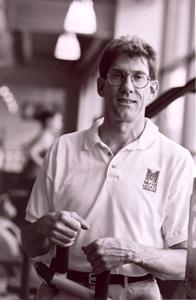
Last week, the American College of Sports Medicine held it's annual meeting in Orlando, and it was a whiriwind of activity (as always). For at least 20 years, now, it's been far too large to take in by oneself. I first went to ACSM as a beginning post-doctoral fellow in cardiovascular physiology, when my mentor Dr. Jere Mitchell generously covered my expenses to go to the meeting in Las Vegas in 1987. My, how things have changed!
In the last 15 years or so, my activities at the annual meeting have shifted substantially from the first 15 years. Today, I find myself going to fewer events about basic exercise science and more to sessions that are about important issues of getting exercise implemented into our health care system. This saddens me some, since by training I was mainly prepared to advance scientific knowledge on exercise in chronic disease, and I miss making that contribution. But today I think the science is less important than overcoming the barriers to getting exercise into the health care system. I do miss being involved in the scientific discussions, and have lost touch with many of my former colleagues. Sometimes we pass in the hallways on the way to sessions, and in a few cases have a few moments to stop and catch up on what we’re each doing. On the flip side of that, I find myself making new friends and colleagues who are also working on implementing Exercise is Medicine™.
The Exercise is Medicine™ initiative by ACSM is expanding dramatically, and much of what I went to in Orlando related to EIM. The seminal idea that started EIM is the notion of getting more physicians to prescribe exercise (or physical activity). One pathway to achieving that is to get more electronic medical records making use of the exercise or physical activity vital sign (EVS / PAVS). The EVS is a component of our SHQ, so while the SHQ is broader than the EVS alone, I share the view that exercise / physical activity is the most important health prescription a doctor can give, and am very interested in work supporting the EVS.
Through the Health & Science Policy committee of ACSM, I moderated a symposium on implementation of EIM - the fundamental tenet of EIM being to get physicians to prescribe exercise / physical activity. One challenge with that goal is that few physicians know enough about exercise to be able to address the many issues that an exercise prescription raises. Writing the prescription itself is not hard for physicians to learn, but patient questions that follow are likely to exceed the physician's knowledge. So many of us believe that the EVS, which hopefully leads to more EIM prescriptions, must be linked to a sustainable business model where clinical exercise physiologists are able to work within the health care system. Our symposium discussed some areas where that system design is beginning to be in place (in the Kaiser-Permanente and Intermountain Healthcare systems), and we also discussed barriers to this model in less-integrated health care systems where it's more difficult to have a sustainable business model.
This issue of implementing a sustainable business model is, of course, very important to us at Sustainable Health Systems, and one reason that we offer consultation services to help subscribers to the SHQ. The EVS and SHQ are only data management tools, though having such tools is an important element in implementing both EIM and lifestyle interventions. To do the EIM model, it is essential to have the EVS as part of the EMR. Taking on comprehensive lifestyle interventions needs a more comprehensive risk assessment tool like the SHQ.
Whether one chooses to implement an exercise prescription or comprehensive lifestyle risk reduction, configuring your health care system to make optimal use of these new tools is - by far - the hardest part of implementing lifestyle interventions in a health care system that is based on payment for disease-care. It’s heartening to go to ACSM and see so many ideas coming forth on how to build these soluutions in a variety of health care systems.
- GE Moore MD's blog
- Log in to post comments
- Follow our Blog
